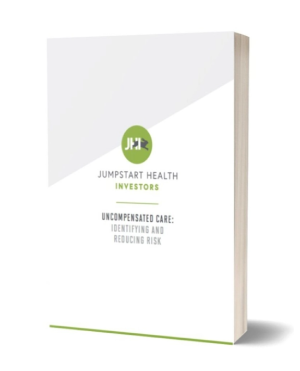Uncompensated Care: Identifying and Reducing Risk
Educate yourself on how to identify and reduce the risks with uncompensated care.
What is uncompensated care? Why is it increasing? Educate yourself on how to identify and reduce the risks with uncompensated care.
Identifying and Reducing Uncompensated Care Risks
Providers have traditionally collected most of their payment from payer organizations such as UnitedHealth, Anthem, or Cigna. Yet more payment responsibility is shifting from payer organizations onto patients.
This increase in patient payment responsibility is largely due to the increase of consumer enrollment in high deductible health plans (HDHPs) and an increase in the number of uninsured patients.
Download The Report Now
Identifying and Reducing Uncompensated Care Risk
With increasing patient self-pay responsibility and decreasing hospital operating margins, the pressure for provider organizations to reduce their uncompensated care levels is increasing. Learn the two main steps providers have to complete to to reduce uncompensated care. In addition, gain insights into the startups that are working to alleviate these risks and an investment recommendation for the market.
Uncompensated Care Defined
Providers have traditionally collected most of their payment from payer organizations such as UnitedHealth, Anthem, or Cigna. Yet more payment responsibility is shifting from payer organizations onto patients. This increase in patient payment responsibility is largely due to the increase of consumer enrollment in high deductible health plans (HDHPs) and a recent increase in the number of uninsured patients. More patients paying out of pocket costs leads to higher levels of care provided that does not result in payment to the provider, known as uncompensated care.
Types Of Uncompensated Care
Uncompensated care comes in two forms. The first form is referred to as charity care. Charity care occurs when care is given but payment is not expected, and is given to those who cannot afford the cost of care. The second type of uncompensated care is bad debt. Bad debt happens when care is given and payment is expected, but payment is not received. Determining how much uncompensated care is bad debt and how much is charity care is difficult.
Provider Pressure
With increasing patient self-pay responsibility and decreasing hospital operating margins, the pressure for provider organizations to reduce their uncompensated care levels is increasing. To reduce uncompensated care, provider organizations have to complete two main steps: First, they need to identify who in their patient population is susceptible to producing uncompensated care. Second, they need to create patient-centric payment plans that either shift the out of pocket cost of care away from those patients or make it more manageable for them.
What You’ll Find Inside

01.
AN OVERVIEW OF THE CHALLENGE OF IDENTIFYING AND REDUCING UNCOMPENSATED CARE RISK
02.
STEPS PROVIDER ORGANIZATIONS NEED TO TAKE TO IDENTIFY AND REDUCE UNCOMPENSATED CARE RISK
03.
STARTUPS MAKING IT EASIER FOR PROVIDERS TO CONDUCT THE STEP & INVESTMENT RECOMMENDATIONS